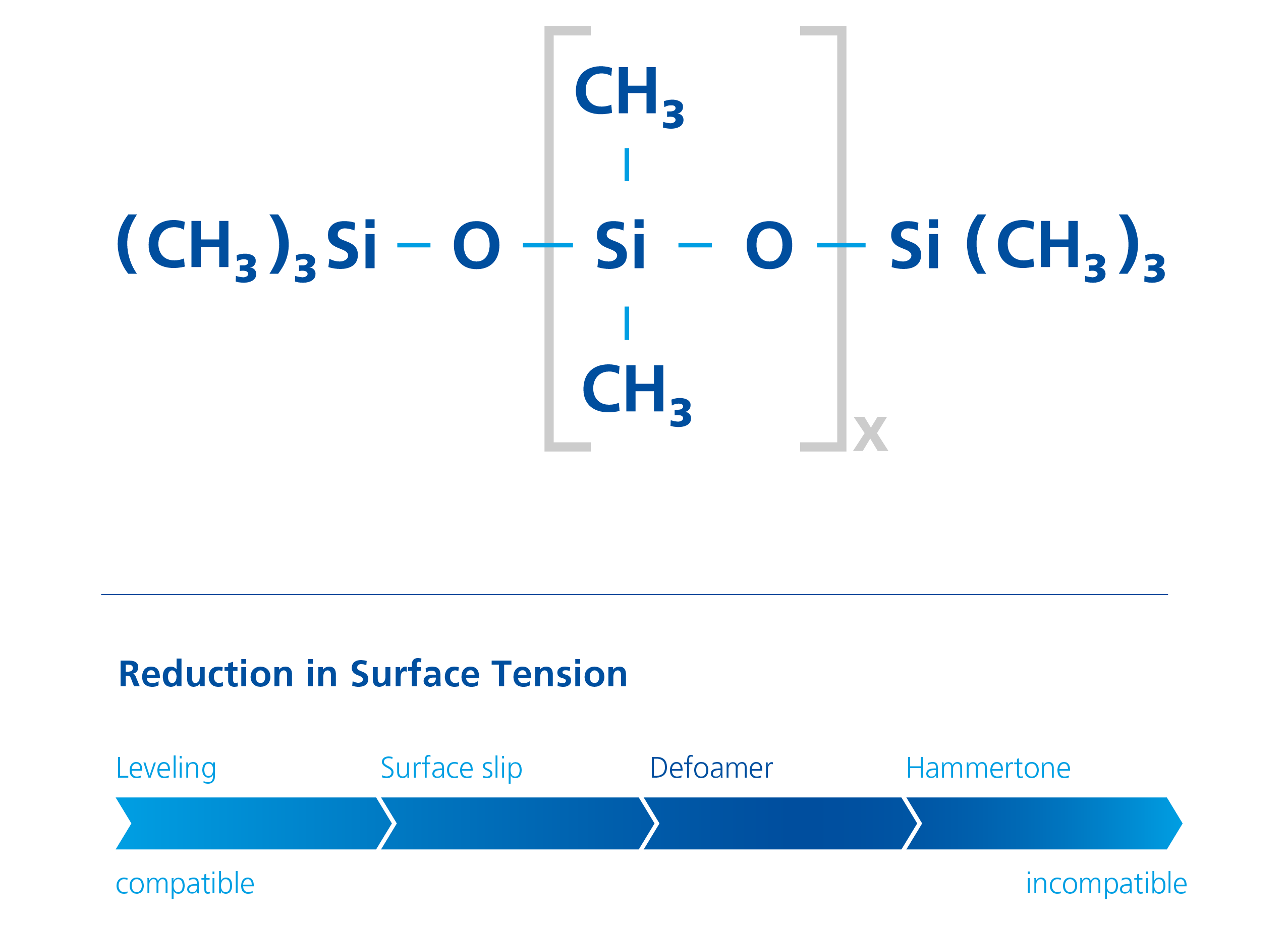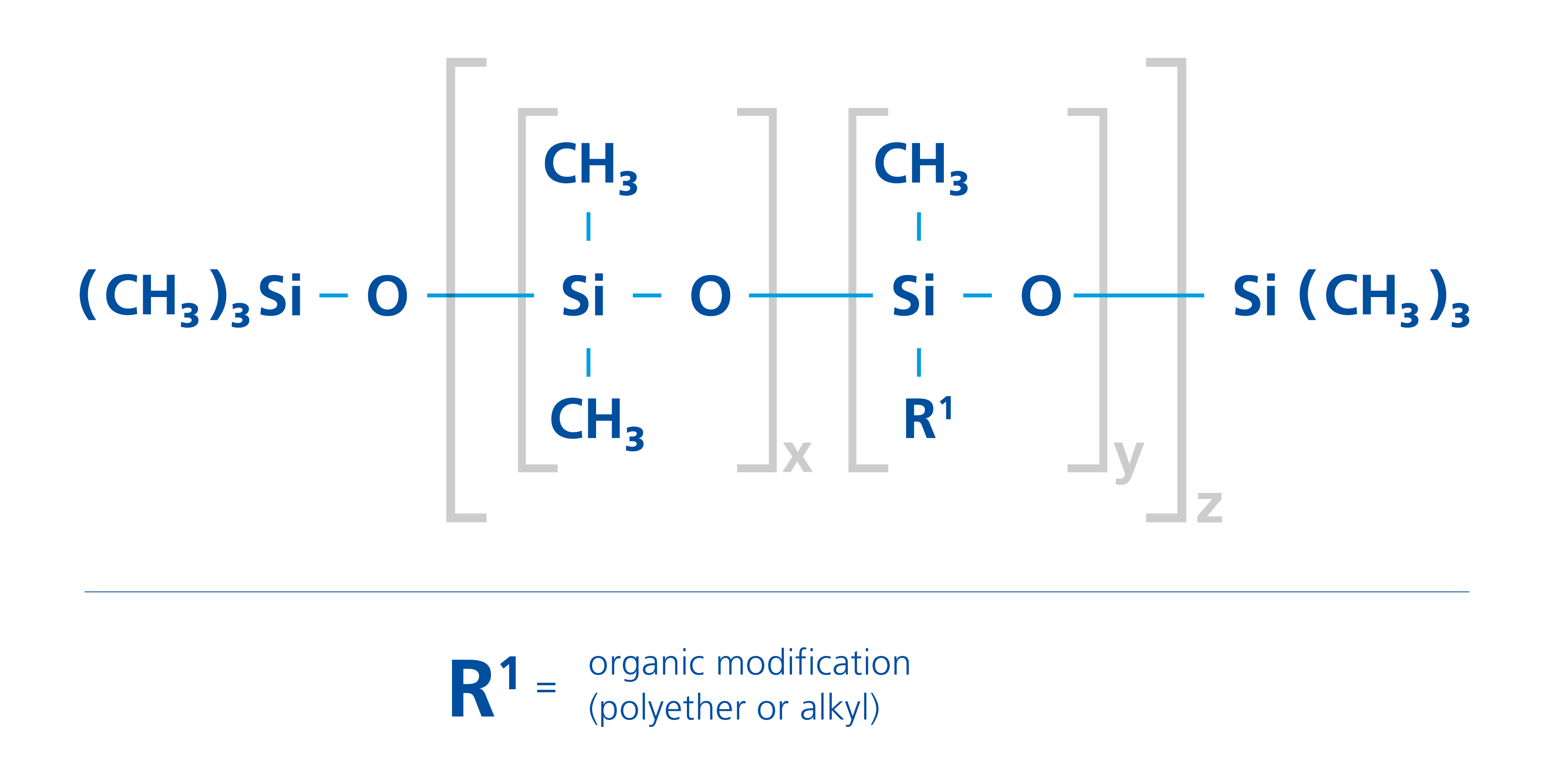- Additives
- Instruments
Silicone defoamers are defoamer fluids with a particularly low surface tension, which contain polysiloxanes as the primary active substance. However, when selecting a polysiloxane, its structure is critical. For instance, the relatively short-chained polysiloxanes that are used as silicone surface additives stabilize foam but have no defoaming effect. Whether a polysiloxane has a defoaming or foam-stabilizing effect depends on its compatibility and solubility in the medium: only incompatible and insoluble polysiloxanes have a defoaming effect.

This figure illustrates this situation for the pure (unmodified) polydimethylsiloxanes. The parameter here is the molecular weightor the chain length of the silicones. Lower molecular weights stabilize foam, higher molecular weights are already so incompatible that they cause cratering, and then there are the entirely incompatible hammer finish silicones. The “specific incompatibility” necessary for the silicone defoamers can be achieved in various ways based on the diverse possibilities that silicone chemistry provides.
Modifying the basic silicone chain with different organic side chains makes it possible to control the compatibility. In this way, polysiloxanes become hydrophilic by introducing polyether chains (R1) based on ethylene oxide, thereby becoming more compatible in polar systems in general. Polyethers based on propylene oxide result in more hydrophobic structures. Instead of dimethylpolysiloxanes, it is also possible to use methyl alkyl polysiloxanes. Replacing the second methyl group with a longer alkyl chain (R2) results in higher levels of surface tension for the silicone. In general, this means reducing the foam-stabilizing effect.

Introducing perfluorinated organic modifications resulted in so-called fluorosilicone defoamers. These products are characterized by a very low surface tension and a high defoaming effect.
Silicone defoamers for aqueous systems
In terms of silicone defoamers for aqueous systems, these are generally emulsions of highly hydrophobic silicone oils. As a result of the silicone matter they are more expensive than mineral oil defoamers and therefore intended for higher-quality coating formulations. Silicone defoamers can also be combined with hydrophobic solids to increase the defoaming effect. The primary advantage of silicone defoamers compared with mineral oil defoamers is that they do not affect gloss in high-gloss systems and they have no impact on color paste acceptance when using color pastes.
% | |
Silicone oil | 5-90 |
Hydrophobic particles | 1-3 |
Emulsifier | 3-6 |
Polyglycol and/or water | 0-85 |
To obtain crater-free coatings it is important to ensure adequate shear forces when incorporating the defoamer. Very incompatible defoamers need to be added at an early stage to the millbase, for more compatible products such as the standard defoamer BYK‑024, the shear forces during the letdown phase are sufficient. The highly compatible defoamer BYK‑025 is characterized by being very easy to incorporate; it can be added easily without curtain tears on the curtain coater. The economical silicone defoamers BYK‑1610 and BYK‑1615 were developed specifically for emulsion paints in the decorative sector. These two products are suitable for replacing the mineral oil defoamers that are predominantly used in emulsion paints and plasters. BYK‑1723, BYK‑1724, BYK‑1611 and BYK‑1617 were specifically developed for applications that need to be labeled with the European ecolabels.
Silicone defoamers for solvent-borne coating systems
BYK‑070, BYK‑088 and BYK‑141 are adjusted to be a little more compatible; the active substance in BYK‑088 conforms to FDA §175.300 and is specifically designed for aromatic-free formulations.
In addition to the original silicone defoamers there is also the group of silicones with defoaming properties. This always relates to polymethylalkylsiloxanes. They are used when the foam problem is not too great and when the defoaming effect is an additional requirement for providing typical silicone properties to the coating system such as high surface slip and preventing Bénard cells. If their defoaming effect is inadequate, they are combined with silicone defoamers or polymer defoamers.
If you delete your search history, all your previous searches will be deleted permanently.